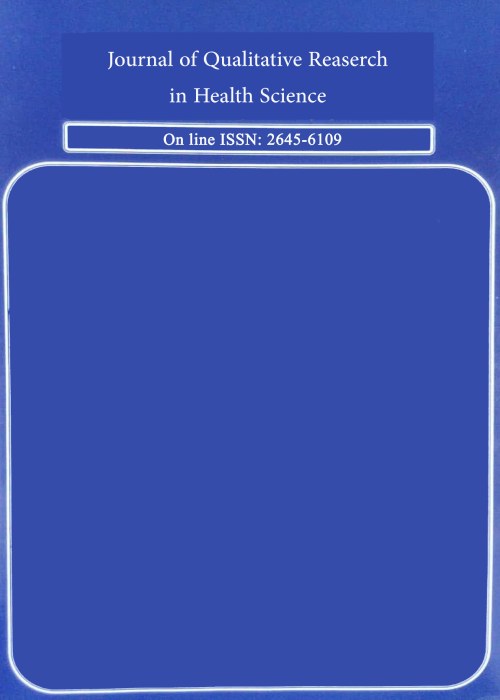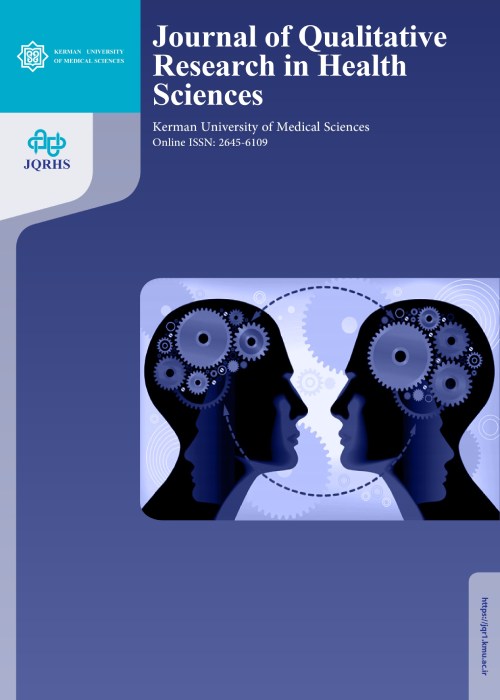فهرست مطالب

Journal of Qualitative Research in Health Sciences
Volume:11 Issue: 3, Autumn 2022
- تاریخ انتشار: 1401/09/10
- تعداد عناوین: 8
-
-
Pages 148-155BackgroundA successful marriage is a dynamic growing relationship in which both partners continue to grow to achieve personal satisfaction. Building a successful life depends on a successful marriage. Therefore, this study aimed to explore the components of a comprehensive model governing on-time marriages among Iranian married men.MethodsThis study was conducted using a qualitative thematic analysis approach. Using a homogeneous purposive sampling method, 14 married men in Bushehr were selected and interviewed. The collected data were analyzed using the content analysis method.ResultsThe analysis of the data from the interviews revealed three main categories related to on-time marriage among men including having a family that supports marriage, a marriage loving character, and the conditions facilitating marriage.ConclusionFollowing these findings, it can be argued that a successful marriage depends on three important components of personality, requirements, and family supporting the on-time marriage. Thus, the improvement of marital life also depends on multidimensional corrections made by taking into account these factors. Accordingly, some measures need to be taken to promote marriage among young people and make them interested in marriages. Furthermore, families need to support their children and provide facilities for them to have successful and on-time marriages. Finally, social institutions and officials are required to facilitate conditions for people to have successful marriages.Keywords: Successful marriage, qualitative research, Thematic analysis
-
Pages 156-163Background
Preparedness is one of the important and effective pre-crisis management stages and involves all actions and programs that enable the organization to respond quickly and effectively in critical situations. To this end, this study aimed to explore the experiences of crisis managers and experts in hospital disaster preparedness.
MethodsThis qualitative study was conducted using conventional content analysis in 2019. The research population included hospital managers and crisis specialists in Ardabil Province. The participants were 14 managers and crisis specialists who were selected using purposive sampling. The data were collected through semi-structured interviews and analyzed using Griesheim and Landman’s qualitative content analysis approach.
ResultsThe analysis of the data revealed four main categories including management and planning, infrastructural development, human resources, and intersectoral coordination.
ConclusionThe findings of the present study highlighted the significance of preparedness for emergencies, management and planning, having codified instructions, and implementation and evaluation to increase the preparedness of hospitals to deal with emergencies.
Keywords: Emergencies, Disasters, Hospitals, Preparedness -
Pages 164-170BackgroundThe increasing growth and adverse effects of internet addiction have made this disorder a factor underlying all behavioral addictions. The present study aimed to explain the process of internet addiction in students of the University of Tehran.MethodsThis qualitative study was conducted based on the grounded theory which is an exploratory research method. The research population included students with internet addiction at the University of Tehran in the academic year 2019-2020. Using purposive sampling and theoretical saturation criteria, 15 students (5 males and 10 females) were selected as the participants in the study. The data were collected through structured interviews with the students.ResultsBased on the analysis of the data from the interviews, the factors effective in the formation of internet addiction were classified into 43 primary themes and 14 subcategories that were summarized into 5 main categories including individual factors, family factors, social factors, educational factors, and features of the internet.ConclusionStudents’ internet addiction can be attributed to personality factors, psychological disorders, and family factors. The findings of this study provided a clear picture of internet addiction. The results of this study can be useful for psychologists and therapists to better understand this phenomenon and plan strategies for the prevention and treatment of internet addiction.Keywords: Internet addiction, Students, Grounded theory, Purposive sampling, Qualitative interviews
-
Pages 171-179BackgroundThis study aimed to investigate the lived experiences of mothers with attention-deficit/ hyperactive children.MethodsThe present qualitative descriptive study was conducted based on a phenomenological approach that investigated the experiences of primary caregivers of attention-deficit/ hyperactive children. The population of the study included mothers of attention-deficit/hyperactive primary school students in Tabriz. A total of 13 children were selected using purposive sampling. Data were collected through face-to-face, in-depth, and semi-structured interviews with participants. The interviews were conducted in schools and the Hasti Counseling Center. Moreover, Smith’s cognitive phenomenological method was used to analyze the data.ResultsThe analysis of the data revealed 4 main themes and 25 subthemes including emotional responses (depression, loneliness, anger and rage, embarrassment, desire to have a calm child, stress, confusion, remorse, regret, frustration, anxiety and dread), behavioral responses (self-blame, frequent crying, shouting, aggression, trying to control oneself), physical responses (palpitation, feeling hot water drops on one’s head), and cognitive responses (feeling inhuman, isolation, feeling guilty, embarrassed, and blameful, problems in pregnancy, insanity, feeling hyperactive due to inability to control oneself, feeling accused of lying).ConclusionThe results of this study will pave the way for further research in the field of mental health interventions for mothers of attention-deficit/hyperactive children. Accordingly, it is essential to design and evaluate the effectiveness of psychotherapy interventions that can cover various dimensions of the problems of this group of mothers.Keywords: Attention-deficit, hyperactivity disorder, Phenomenological Study, Mothers
-
Pages 180-188IntroductionStigma refers to a set of negative attitudes, beliefs, behaviors, and thoughts in dealing with a person who has a chronic disease or some health problems. Cancer is one of the diseases associated with stigma. Stigma causes harmful psycho-social effects for the affected person and family members and is considered an obstacle in disease screening and control programs. Accordingly, this study aimed to explore the nature of cancer stigma and its consequences and influencing factors in Iranian society.MethodsA total of 14 people including cancer patients, their families, and healthcare staff participated in this qualitative study. The participants were selected using purposive sampling and the data were collected through semi-structured interviews. The resulting data were analyzed using conventional content analysis and with MAXQDA software (version 10).ResultsThe content analysis revealed four themes including cancer as a terrifying and pitiful disease, identity crisis/psychosocial disintegration, disease complexity, and public unawareness and community problems.ConclusionThere are many negative beliefs and stereotypes about cancer and affected people, which are exacerbated by public unawareness and lack of sufficient information about cancer, as well as lack of comprehensive support. These beliefs and stereotypes adversely affect the quality of life of affected people. Following the findings of the study, some interventions need to be implemented to reduce stigma, increase the quality of life, and improve the treatment process for cancer patients.Keywords: cancer, Stigma, qualitative research, content analysis
-
Nurses’ Challenges in Caring for Patients with COVID-19: A Qualitative StudyPages 189-195Background
Nurses who care for patients with coronavirus disease 2019 (COVID-19) face challenges in providing care for these patients. This study aimed to explain the nurses’ perception of challenges in caring for patients with COVID-19.
MethodsThis study was carried out using the content analysis method in 2020. In this study, 28 nurses were selected via purposive sampling. Individual and semi-structured interviews were conducted to collect the data. Data collection continued until data saturation. Content analysis was used to categorize the data and the method proposed by Elo and Kyngäs was also applied to analyze the data.
ResultsNurses’ challenges were classified into three categories including organizational problems, defective communication process, and psychosocial challenges. The first category was divided into two subcategories including shortage of nurses and lack of personal protective equipment. The second category included two subcategories of defective communication with colleagues and defective communication with the patients and their families. Moreover, the third category was classified into two subcategories including psychological distress and sociocultural challenges.
ConclusionTo address the challenges of nurses in caring for patients with COVID-19, the shortage of nurses should be eliminated. Nurses need to participate in comprehensive communication skills training courses. Furthermore, it is necessary to develop educational programs and present them to the public based on the cultural context of the society.
Keywords: Caring, Coronavirus disease-2019, Nurses, Challenge, Qualitative research -
Pages 196-205IntroductionNightmares are prevalent parasomnia associated with various forms of psychological distress in both the clinical and general population. The aim of the current study was to explain the experiences of the client regarding the effects of nightmares and the process of dream analysis treatment on idiopathic nightmares.MethodsIn this qualitative study, the client was a 34-year-old woman who participated in 8 sessions of dream analysis treatment. Based on DSM-5, she had the criteria of a nightmare. Rich data were collected from her. The hermeneutic method was used to collect and analyze quantitative and qualitative data. This study used a simple method to perform the hermeneutic analysis that requires only one person while maintaining its validity.ResultsThe findings showed that the frequency of nightmares decreased during the treatment. The client changed significantly during the treatment, and the dream analysis was also responsible for this change. According to Bohart’s criteria, the client changed with at least 72% confidence and with 87% confidence this change in relation to external factors happened as a result of the treatment. Useful therapeutic factors included examining the hidden meaning of nightmares, expressing emotions, self-awareness, and reducing helplessness.ConclusionThe results of the interventions showed that treatment processes made changes in the client that were unexpected and important to her and these changes would not have happened without the treatment. This method, in addition to exposing the person to the content of the nightmare, leads to the discovery and decoding of the content of the nightmare and understanding of its message to resolve conflicts.Keywords: Idiopathic nightmare, Dream analysis, Case study, Hermeneutic
-
Pages 206-217Background
The only way to present nursing as a profession, in its own right, is to develop its theories. The pursuit of further clarity may enable pediatric nurses to plan for further studies and use appropriate theories in practice. This needs an inquiry to start with a review of existing literature from various research fields to clarify key knowledge and gaps. Therefore, this study aimed to review studies on nursing theories in pediatric settings.
MethodsThe study design was a systematic review with a qualitative synthesis approach. The inclusion criteria were articles written in English published from 2000 to 2020, focusing on developing a new theory or using previous nursing theories in pediatric settings, in PubMed, Scopus, Ovid, and EBSCO databases. The exclusion criteria were the articles written in languages other than English, settings other than pediatric, and not finding the full text. The qualitative synthesis was used to integrate the data using MAXQDA10.
ResultsThe results of data analysis showed 24 new theories were developed by the grounded theory approach regarding parenting, nurse-family interaction, and improving nursing care. Moreover, the theories of some nursing scholars, such as Orem and Watson, were mostly used as a framework in studies on cancer (18.96%) and critically-ill children, especially adolescents (21.81%).
ConclusionThis study clarified the trend of nursing theories in pediatric settings and highlighted the gaps in the literature, over the last two decades. The study provides implications for future studies regarding nursing theories in pediatric settings and, encourages nurses to strive in the journey of professionalization by utilizing and developing more nursing theories. Future studies can focus on other aspects, such as primary and tertiary prevention in different age groups or the most prevalent diseases in children.
Keywords: Nursing theory, children, Pediatric, Pediatric nursing


